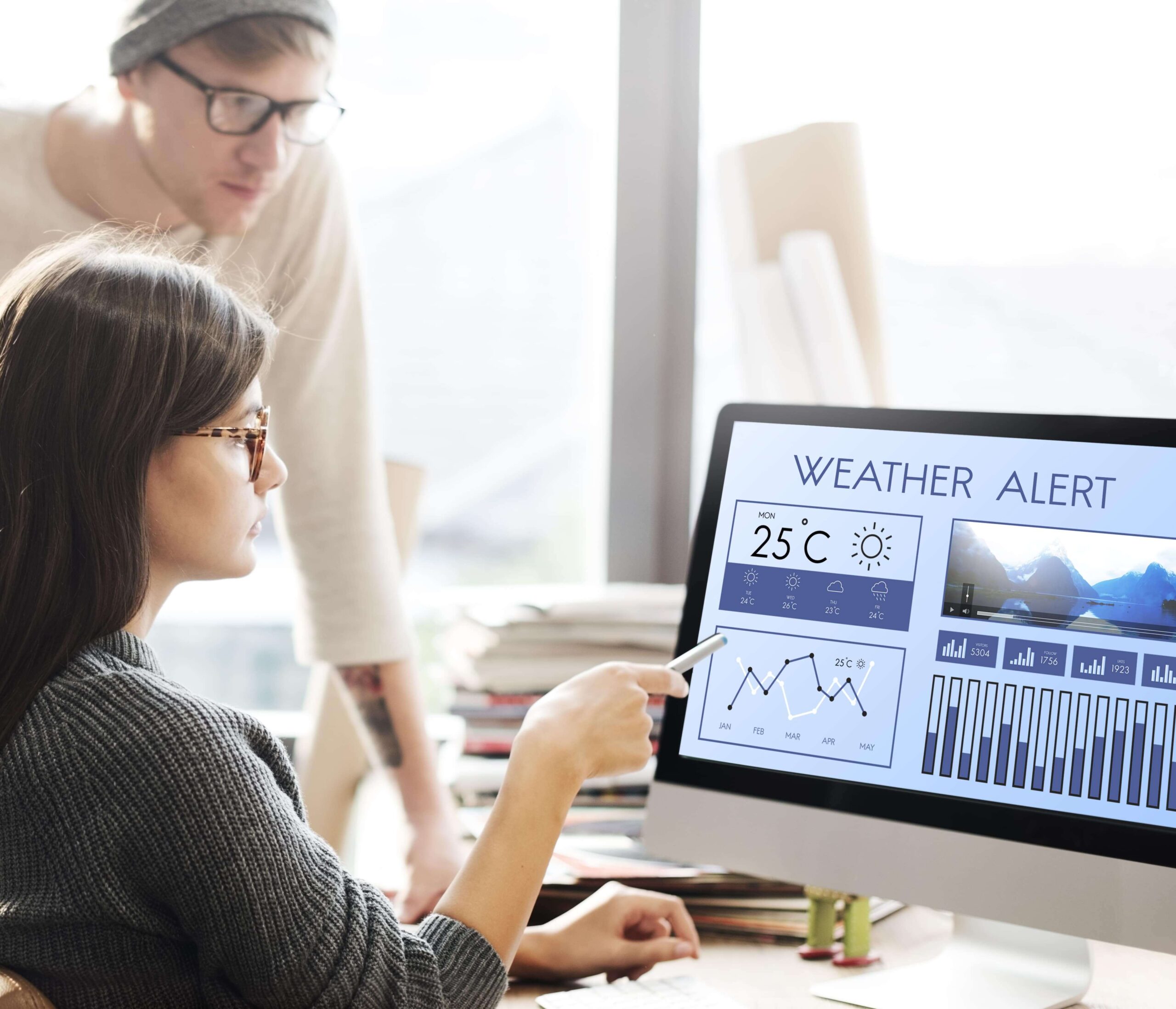- AI-powered flood prediction models predict extreme weather up to a week in advance
- Early warning system uses AI to predict tsunami risks
- This AI will help you get out of the way of an incoming hurricane
As the world grapples with the ever-increasing challenges posed by climate change and a rapidly growing population, the need for advanced technologies to predict and mitigate the impact of natural disasters has never been more pressing. With the summer of 2023 officially becoming the hottest on record and extreme weather events claiming millions of lives and causing trillions of dollars in economic losses over the past five decades, it is clear that traditional weather forecasting methods are no longer sufficient to protect vulnerable communities and safeguard our planet’s future. This is where artificial intelligence technology comes in. By harnessing the power of machine learning algorithms and vast datasets, AI has the potential to dramatically alter weather forecasting, providing meteorologists with unprecedented insights into the complex and ever-changing patterns of our climate.
The stakes could not be higher. As the World Meteorological Organisation recently revealed, a staggering 11,800 disasters related to weather, climate, and water hazards have been recorded worldwide between 1970 and 2021, with developing countries bearing the brunt of the impact (about 60 per cent of losses and 90 per cent of deaths). Accurate and timely forecasts are not just a matter of convenience; they are a matter of life and death, particularly in regions where even minimal errors in temperature predictions can lead to a surge in mortality rates. But the potential benefits of AI-powered weather forecasting extend far beyond saving lives. By providing farmers with precise information about optimal planting times and crop protection strategies, AI can help to ensure food security for millions of people around the world. And by enabling governments and businesses to better prepare for and respond to extreme weather events, AI can help to minimise property damage and the resulting economic losses that have already reached a staggering $4.3 trillion since 1970.
“We can tell you that in five days you will have 50 cm of water at your entrance, and we can tell you when it will subside”.
Jonas Borland, the founder of 7Analytics
AI-powered flood prediction models predict extreme weather up to a week in advance
From the bustling streets of New York City to the low-lying coastal regions of Southeast Asia, almost no corner of the world is safe from the threat of rising waters. Experts predict that coastal flooding could reach catastrophic levels by 2100, with cities around the world facing a sea level rise of nearly two metres. The consequences of such development would be nothing short of disastrous. It would displace millions of people, destroy infrastructure, and wreak havoc on local economies. In the face of this looming crisis, conventional flood prediction methods have proven woefully inadequate. Traditionally, flood prediction relied on physics-based models that used standard computing power to assess the risk of incoming flooding, often with questionable accuracy. The tragic events in Waverly, Tennessee, in August 2021, serve as a grim illustration of the limitations of these models. Despite meteorologists predicting a mere five to eight centimetres of rain, the area was hit with more than 50 centimetres, resulting in the loss of 20 lives.
Unlike traditional models, AI-powered flood prediction takes into account a wide range of factors. In addition to the weather forecast, it also keeps track of the nearby land and rivers, drainage information about the area, and regional layout. By analysing data from such a wide array of sources, AI can create a more comprehensive and nuanced picture of flood risk. One of the key advantages of AI in flood prediction is its superior computing power. AI models can process vast amounts of data much more quickly and with less human oversight than traditional methods, enabling faster and more accurate predictions. This is particularly important in the face of the growing frequency and intensity of extreme weather events, which require rapid and precise forecasting to minimise loss of life and property damage.
For example, the Norway-based sustainability data platform 7Analytics developed an AI model that can accurately predict which areas will be hit by a catastrophic weather event up to a week in advance, allowing local businesses and authorities to better prepare and respond to incoming flooding. “All of this data takes into account where the water will flow and where it will create problems”, explains Jonas Borland, the company’s founder. “We can tell you that in five days you will have 50 cm of water at your entrance, and we can tell you when it will subside”. Similarly, tech giant Google recently released a new platform called Flood Hub, which uses AI to provide river flood warnings for more than 80 countries in the world. By analysing satellite images of rivers and nearby terrain, the system can predict how likely rivers are to flood in the event of rainfall. It can then alert the affected communities two to seven days before it actually happens. “Floods are one of the most devastating natural disasters and impact hundreds of millions of people per year”, says Yossi Matias, vice president of engineering and research and crisis response lead at Google. “We really want to let people know before floods actually hit them”.
An early warning system uses AI to predict tsunami risks
The destructive power of tsunamis is yet another reminder of the fragility of human life in the face of nature’s fury. These towering waves, typically triggered by underwater earthquakes, can travel at breakneck speeds, reaching up to 800 kilometres per hour in the open ocean before slowing to a still-formidable 50 to 80 kilometres per hour as they get near the coastline. The consequences of a tsunami’s impact can be downright catastrophic, with entire communities succumbing in a matter of moments. Despite the existence of early warning systems, which rely on seismic waves generated by undersea earthquakes, predicting the occurrence and severity of tsunamis remains a daunting challenge. Even with seismographs and buoys in place to detect potential threats, false alarms are not uncommon, and the window for evacuation can be alarmingly short.
Recognising the limitations of current warning systems, researchers from the University of California, Los Angeles and Cardiff University have developed a groundbreaking early warning system that combines AI and advanced acoustic technology to detect earthquakes and predict how likely they are to result in a tsunami. The Global Real-time Assessment of Tsunami (GREAT), as the system is called, employs two separate algorithms to analyse incoming seismic data. First, an AI model assesses the magnitude and type of an earthquake, distinguishing between vertical and horizontal tectonic slips. This distinction is crucial, as vertical earthquakes that raise or lower the ocean floor are far more likely to generate tsunamis than their horizontal counterparts, which can produce similar seismic activity but pose a much lower risk. By accurately identifying the nature of the seismic event, the system can significantly reduce the incidence of false alarms. Once the AI model has determined the characteristics of the earthquake, an analytical model takes over, which assesses the potential size and direction of the resulting tsunami. According to Dr Usama Kadri, a researcher and lecturer at Cardiff University, the GREAT system can very accurately predict the tsunami’s source, size, and the coasts most likely to be impacted — all within 17 seconds of receiving the seismic data.
The implications of this rapid assessment capability are far-reaching. With earlier and more accurate warnings, coastal communities would have precious additional time to evacuate, potentially saving countless lives. The integration of the GREAT system into existing tsunami warning centres could have significant financial implications as well. By reducing the incidence of false alarms, the system could help minimise the costs associated with unnecessary business shutdowns and coastal evacuations. This, in turn, could free up resources to be invested in other critical aspects of disaster preparedness and response. It’s also important to note that, while earthquakes are responsible for the vast majority of tsunamis, these destructive waves can also be triggered by a range of other factors, including landslides, volcanic eruptions, extreme weather events, and even meteorite impacts. Thanks to its ability to monitor the vertical motion of water regardless of the cause, the GREAT system could be helpful in warning against tsunamis from these sources as well.
“The main advantage of this AI approach is that it’s extremely accurate. It learns from decades of data and is able to be more accurate than the industry gold standard”.
Remy Lam of Google DeepMind
This AI will help you get out of the way of an incoming hurricane
For decades, traditional weather forecasting has relied on numerical weather prediction (NWP) models, which take in vast amounts of atmospheric data from a variety of sources, including weather stations, satellites, balloons, and even sensors on commercial jet planes. These models use complex equations to simulate the behaviour of the Earth’s atmosphere, allowing forecasters to predict how weather patterns will evolve over time. While this approach has proven remarkably successful, with forecasts becoming increasingly accurate as models have improved and computing power has increased, it does also have drawbacks. One of the primary limitations of NWP models is the immense computational resources they require. Running these models involves processing quadrillions of calculations every second, a task that can only be accomplished by some of the world’s most powerful supercomputers. Even with this enormous computing power, generating a single forecast can take hours, limiting the frequency with which predictions can be updated. This could potentially delay the dissemination of critical information.
To address these challenges, Google DeepMind has developed GraphCast, a new AI tool that promises to transform the field of weather forecasting. Unlike NWP models, GraphCast does not attempt to simulate the Earth’s atmospheric conditions. Instead, it uses machine learning algorithms to analyse massive amounts of historical weather data, including the output of the European Medium Range Weather Forecasting (ECMRWF) model, one of the world’s most respected forecasting systems. By learning from this historical data, GraphCast can identify patterns and relationships that allow it to predict how current weather conditions are likely to evolve in the future. “The main advantage of this AI approach is that it’s extremely accurate”, says Remy Lam of Google DeepMind, one of the tool’s creators. “It learns from decades of data and is can be more accurate than the industry gold standard”. In fact, according to a peer-reviewed paper published in the journal Science, GraphCast outperforms the ECMRWF model on more than 90 per cent of key weather factors. This impressive feat is made all the more remarkable by the fact that GraphCast can generate its forecasts in a fraction of the time it takes traditional methods, using only a small portion of the computing power.
One area where the ECMRWF model remains superior to GraphCast is that its forecasts offer far more details. On the other hand, GraphCast does a better job of predicting the path of big storms like hurricanes. For example, while the ECMRWF model was able to forecast the path of Hurricane Lee six days in advance — a powerful storm that struck the Atlantic coast of the United States and Canada in September — GraphCast successfully predicted its landfall nine days ahead of time, providing a crucial additional window of time for preparations and evacuations. Despite its impressive performance, it is important to note that GraphCast is not intended to fully replace traditional weather forecasting methods. “AI models are trained from data, and that data is generated by traditional approaches, so we still need the traditional approach to gather data to train the model”, adds Lam. Rather than supplanting NWP models, AI tools are likely to complement and enhance them, working in tandem to provide the most accurate and comprehensive forecasts possible.
Closing thoughts
As climate change continues to exacerbate the frequency and intensity of extreme weather events, the need for innovative solutions has never been more urgent. By using AI to analyse vast amounts of historical and real-time data, we can develop more comprehensive and nuanced models that account for a wide range of factors, which will enable faster and more accurate predictions. This, in turn, can provide critical lead time for evacuations and allow businesses and governments to better prepare for and respond to impending disasters.
By combining the strengths of both human intuition and machine intelligence, we can create a more robust, accurate, and responsive weather forecasting infrastructure that is better equipped to face the challenges of our rapidly changing climate. However, as we increasingly rely on these sophisticated tools to guide our decisions and shape our future, we must also confront the profound questions they raise about the role of technology in our lives. Can we truly trust the algorithms that underpin these systems, or will we find ourselves at the mercy of machines that we can no longer fully understand or control?




